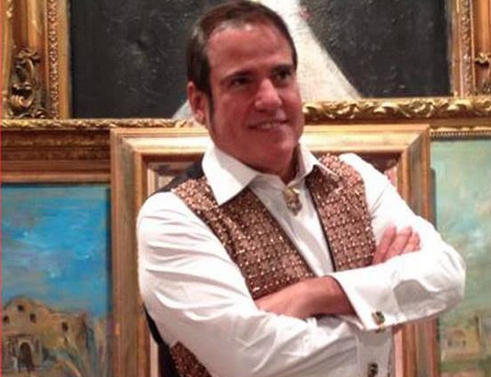Franco Mondini Ruiz calls San Antonio home, but he has enough history in New York that the Big Apple is also home to him. He is a fearless artist inclined to live multiple lives and thus has managed to master the art of painting, installation, structure, interior decoration and writing. He could make a living working solely in any one of these mediums, but he prefers to engage in artistic creations.
To some extent, he reminds me of Pablo Picasso whom we know often started a painting in the morning, worked at mid day decorating plates, and ended the evening building a clay model for a bronze sculpture. Mondini-Ruiz doesn’t work with clay or bronze, but he does many other creative things exceedingly well.
Mondini-Ruiz presently lives and works in a former tortilla factory in Southtown. Whether you are an art lover or a curious tourist, walking into his Presa Street studio one experiences what it must feel like to be a part of a huge art installation. Every inch of the gallery is filled with artifacts and antique-like memorabilia. All these objects crowd his large paintings, but a path has been left clear to enter his work area where more paintings and a few artifacts are stacked.
Since returning to San Antonio in 2006 after living in New York, Mondini-Ruiz has devoted himself to twelve to fifteen hours daily to create art. He stays busy because he has cultivated many art lovers, including Supreme Court Justice Sonia Sotomayor, who bought sixty small paintings for her 60th birthday. He can work days on a landscape or produce an excellent portrait in less than an hour.
Mondini-Ruiz hasn’t always been an artist. He graduated from Saint Mary’s University Law School in the late 1980s and went to work for USAA in their legal office. The money was good, but he was not happy. One day he decided to quit and follow his passion—art.
The San Antonio community has followed Mondini-Ruiz since he made his creative debut in the mid 1990s with his ”Infinito Botanica,” a Southtown artistic gallery where he filled a former botanical store with his installations and sold the art of local artists. The space was also filled with folk art and a few pre-Columbian artifacts.
In 1996 Monidini-Ruiz had his first big artistic break with his selection by ArtPace for the International Artist-in-Residence Program. For his residency, he installed a version of his “Infinito Botanica” store at ArtPace. Art critic Frances Colpitt describes this installation as “a fluid exchange of cultural objects—historical, ethnic, sexual and religious….elegant to behold, Infinito sets up a confluence of worlds mirroring one another into infinity.”
The ArtPace residency opened new doors for Mondini-Ruiz and in 2000 his art was included in the Whitney Biennial. The Whitney Biennial is considered one of the leading art shows in the world, often setting or leading trends in contemporary art. It first started in 1932 and has always focused on identifying young, talented artists who have yet to reach prominence. Since its beginning, the Whitney Biennial has enhanced the careers of artists like Georgia O’Keeffe, Jackson Pollock and Jeff Koons.
Mondini-Ruiz’ participation in the ArtPace residency and inclusion in the Whitney Biennial contributed to his selection in 2005 for the American Academy Rome Prize. One of thirty scholars and artists selected for this prize, he spent a year in Rome, Italy and began showing internationally with exhibits in Prague, Madrid, Helsinki and Bologna.
The Smithsonian American Art Museum collected one of Mondini Ruiz’ best known pieces, Crystal City, for an exhibition titled Our America: The Latino Presence in American Art. It is a tabletop installation which the curators noted is a gathering of “disparate objects—crystal stemware, mirrors, and inexpensive tchotchkes—designed to resemble a city seen from above.”
In the early 1970s, Latinos in Crystal City, Texas engaged in a prolong battle for civil rights which included demands for Latino representation in city government. Latinos made up 80% of the population of this small South Texas town, but not a single Latino had served in city government in the entire century. In the Smithsonian exhibition, Mondini-Ruiz “expresses his ideas about what motivated the quest for equal rights.”
Mondini-Ruiz’ work is popular in San Antonio and his iconic images of women in fancy clothes—often with poodles— as well as other images of birthday cakes and chandeliers, decorate many homes and small shops. One can always count on a witty title or reference in his paintings. “The Last Brunch,” for example, shows a table surrounded by Mariachis. A painting of a wedding couple standing next to a century plant has the title “Wedding of the Century.” Mondini Ruiz is a talented artist with a mission—to make a living as an artist and to have fun with his work.
About the Cover Artist: Franco Mondini Ruiz









